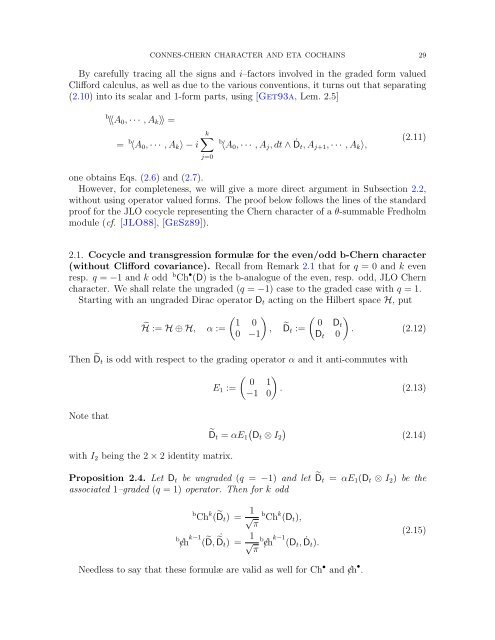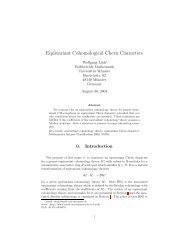Connes-Chern Character for Manifolds with Boundary and ETA ...
Connes-Chern Character for Manifolds with Boundary and ETA ...
Connes-Chern Character for Manifolds with Boundary and ETA ...
You also want an ePaper? Increase the reach of your titles
YUMPU automatically turns print PDFs into web optimized ePapers that Google loves.
CONNES-CHERN CHARACTER AND <strong>ETA</strong> COCHAINS 29<br />
By carefully tracing all the signs <strong>and</strong> i–factors involved in the graded <strong>for</strong>m valued<br />
Clif<strong>for</strong>d calculus, as well as due to the various conventions, it turns out that separating<br />
(2.10) into its scalar <strong>and</strong> 1-<strong>for</strong>m parts, using [Get93a, Lem. 2.5]<br />
b 〈〈A 0 , · · · , A k 〉〉 =<br />
= b 〈A 0 , · · · , A k 〉 − i<br />
k∑<br />
j=0<br />
b 〈A 0 , · · · , A j , dt ∧ Ḋt, A j+1 , · · · , A k 〉,<br />
(2.11)<br />
one obtains Eqs. (2.6) <strong>and</strong> (2.7).<br />
However, <strong>for</strong> completeness, we will give a more direct argument in Subsection 2.2,<br />
<strong>with</strong>out using operator valued <strong>for</strong>ms. The proof below follows the lines of the st<strong>and</strong>ard<br />
proof <strong>for</strong> the JLO cocycle representing the <strong>Chern</strong> character of a θ-summable Fredholm<br />
module (cf. [JLO88], [GeSz89]).<br />
2.1. Cocycle <strong>and</strong> transgression <strong>for</strong>mulæ <strong>for</strong> the even/odd b-<strong>Chern</strong> character<br />
(<strong>with</strong>out Clif<strong>for</strong>d covariance). Recall from Remark 2.1 that <strong>for</strong> q = 0 <strong>and</strong> k even<br />
resp. q = −1 <strong>and</strong> k odd b Ch • (D) is the b-analogue of the even, resp. odd, JLO <strong>Chern</strong><br />
character. We shall relate the ungraded (q = −1) case to the graded case <strong>with</strong> q = 1.<br />
Starting <strong>with</strong> an ungraded Dirac operator D t acting on the Hilbert space H, put<br />
( )<br />
1 0<br />
˜H := H ⊕ H, α := , ˜Dt :=<br />
0 −1<br />
( )<br />
0 Dt<br />
. (2.12)<br />
D t 0<br />
Then ˜D t is odd <strong>with</strong> respect to the grading operator α <strong>and</strong> it anti-commutes <strong>with</strong><br />
E 1 :=<br />
( )<br />
0 1<br />
. (2.13)<br />
−1 0<br />
Note that<br />
˜D t = αE 1<br />
(<br />
Dt ⊗ I 2<br />
)<br />
(2.14)<br />
<strong>with</strong> I 2 being the 2 × 2 identity matrix.<br />
Proposition 2.4. Let D t be ungraded (q = −1) <strong>and</strong> let ˜D t = αE 1 (D t ⊗ I 2 ) be the<br />
associated 1–graded (q = 1) operator. Then <strong>for</strong> k odd<br />
b Ch k (˜D t ) = 1 √ π b Ch k (D t ),<br />
b /ch k−1 (˜D, ˙ ˜D t ) = 1 √ π b /ch k−1 (D t , Ḋt).<br />
(2.15)<br />
Needless to say that these <strong>for</strong>mulæ are valid as well <strong>for</strong> Ch • <strong>and</strong> /ch • .

















